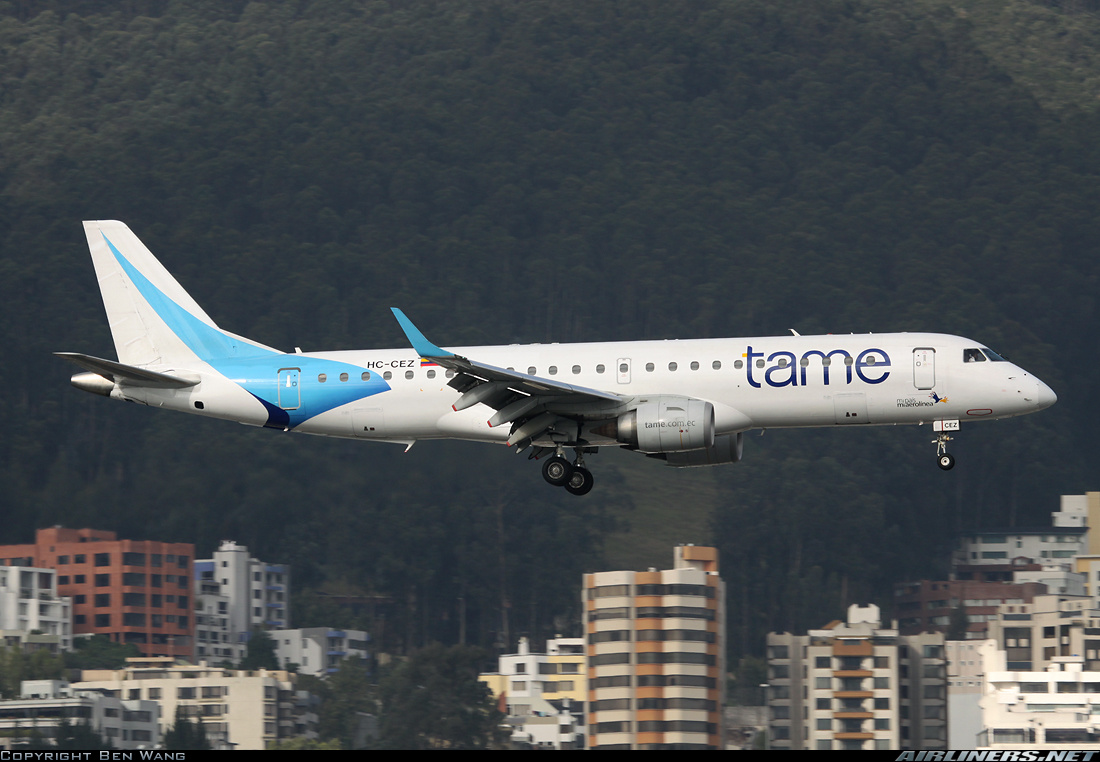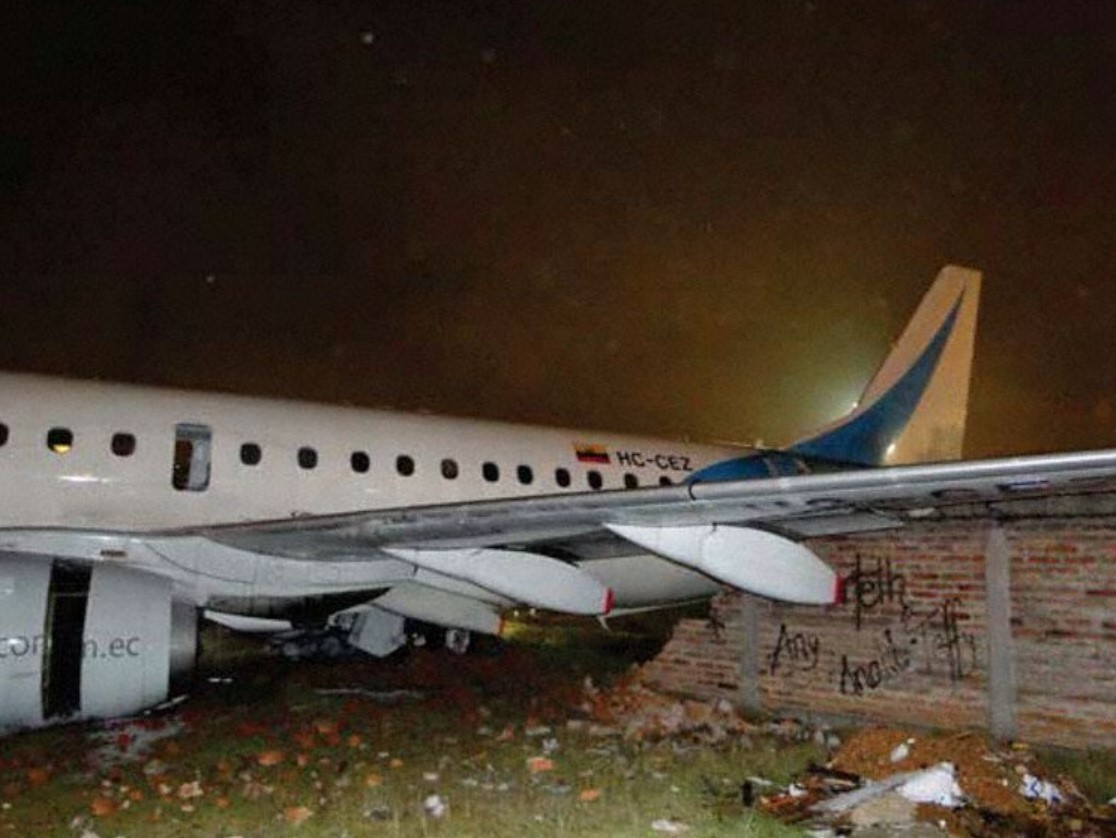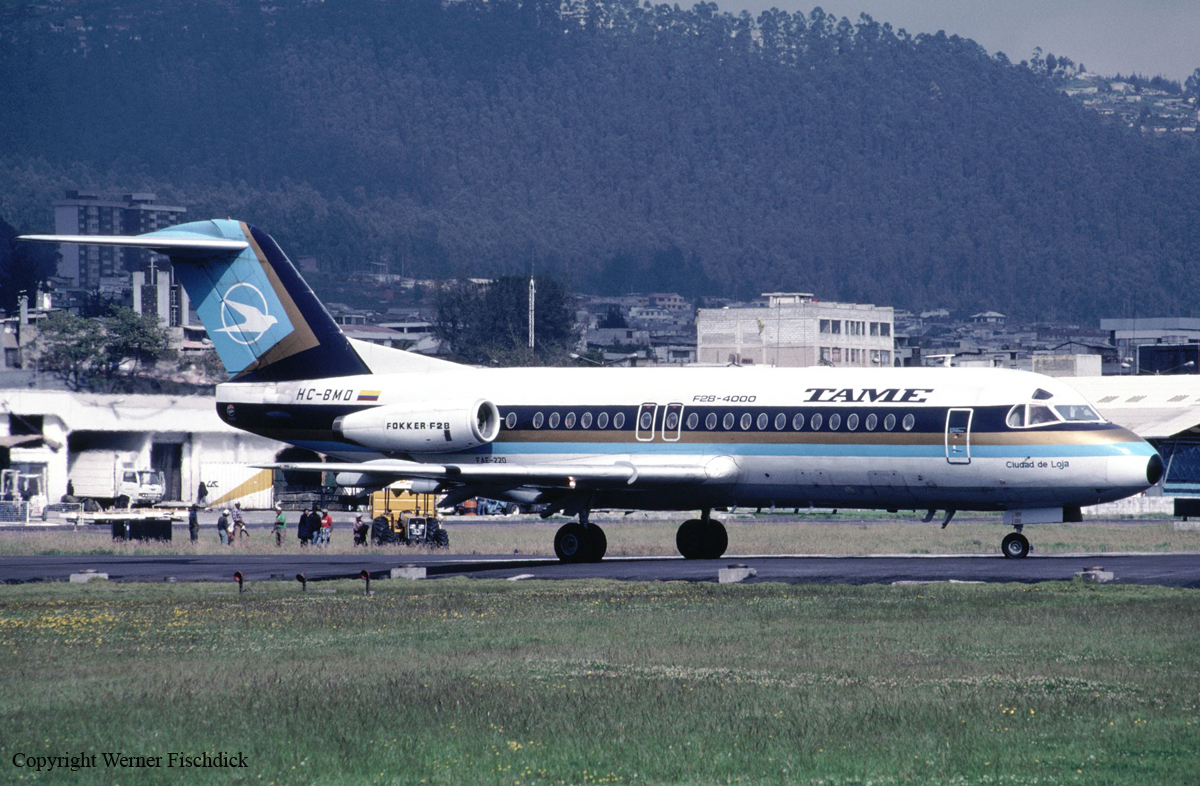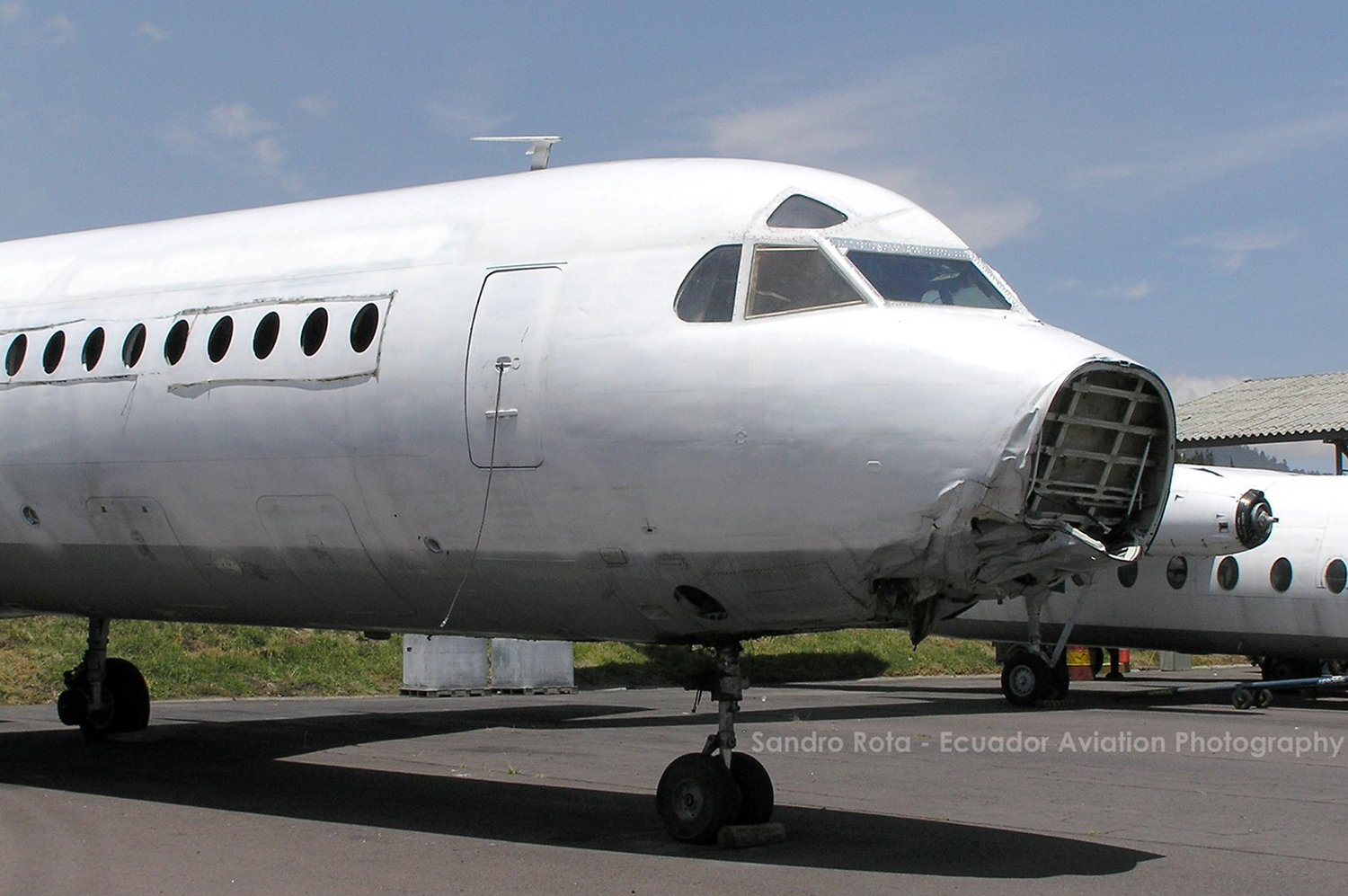Country
Operator Image
Crash of an Embraer ERJ-190-100AR in Cuenca
Date & Time:
Apr 28, 2016 at 0751 LT
Registration:
HC-COX
Survivors:
Yes
Schedule:
Quito – Cuenca
MSN:
190-00372
YOM:
2010
Flight number:
EQ173
Crew on board:
6
Crew fatalities:
Pax on board:
87
Pax fatalities:
Other fatalities:
Total fatalities:
0
Captain / Total hours on type:
2113.00
Copilot / Total hours on type:
2077
Aircraft flight hours:
11569
Aircraft flight cycles:
9707
Circumstances:
Following en uneventful flight from Quito, the crew initiated the descent to Cuenca-Mariscal La Mar Airport Runway 23. Weather conditions at destination were poor with rain falls and a contaminated runway. The pilot-in-command continued the approach below the glide and the aircraft passed over the runway threshold at a height of 37 feet instead the recommended 50 feet. The airplane landed 277 metres past the runway threshold at a speed of 127 knots and the crew activated the spoilers and the reverse thrust systems. Due to poor braking action, the captain activated the autobrake system, without success. As the aircraft could not be stopped within the remaining distance, the captain intentionally turn to the right when the aircraft ground looped, overran and came to rest in a grassy area. All 93 occupants were rescued, among them two passengers were slightly injured. The aircraft was damaged beyond repair.
Probable cause:
The following findings were identified:
- The condition of the runway at Cuenca airport, which at the time of the plane's landing was contaminated with water and slippery.
- The landing was made after a non-stabilized approach with a tailwind.
- During seven seconds, the crew continued the approach with an excessive rate of descent of 1,186 feet, 186 feet above the limit of 1,000 feet.
- The non-application of the Maximum Performance Landing procedure recommended by the aircraft manufacturer for landing on contaminated runways.
- The dispatch of the flight with 1,500 kg of fuel more than the amount of fuel usually used for this flight.
- Omission of the runway length calculation necessary to perform the landing using the braking efficiency information.
- The crew's decision to make the final approach with three red and one white lights, using the PAPI system, induced by the information in the Terminal Information document issued by the company, which authorized this procedure.
- The use of confusing terminology in the Terminal Information document, which used terms applicable to the Airbus fleet, instead of Embraer's.
- The crew's decision not to perform the thwarted approach maneuver after the maximum allowable vertical speed was exceeded and visibility was apparently limited after the minima were exceeded.
- Incorrect use of aircraft braking aids, in this case reverse braking aids
- The application of the emergency brake that inhibits the antiskid system.
- Lack of implementation of adequate management of crew resources, particularly within the cockpit.
- Lack of training in the use of tables for track distance calculation.
- In reference to landing conditions, the aircraft needed a runway length of 2,122 metres while the available distance was 1,900 metres.
- The condition of the runway at Cuenca airport, which at the time of the plane's landing was contaminated with water and slippery.
- The landing was made after a non-stabilized approach with a tailwind.
- During seven seconds, the crew continued the approach with an excessive rate of descent of 1,186 feet, 186 feet above the limit of 1,000 feet.
- The non-application of the Maximum Performance Landing procedure recommended by the aircraft manufacturer for landing on contaminated runways.
- The dispatch of the flight with 1,500 kg of fuel more than the amount of fuel usually used for this flight.
- Omission of the runway length calculation necessary to perform the landing using the braking efficiency information.
- The crew's decision to make the final approach with three red and one white lights, using the PAPI system, induced by the information in the Terminal Information document issued by the company, which authorized this procedure.
- The use of confusing terminology in the Terminal Information document, which used terms applicable to the Airbus fleet, instead of Embraer's.
- The crew's decision not to perform the thwarted approach maneuver after the maximum allowable vertical speed was exceeded and visibility was apparently limited after the minima were exceeded.
- Incorrect use of aircraft braking aids, in this case reverse braking aids
- The application of the emergency brake that inhibits the antiskid system.
- Lack of implementation of adequate management of crew resources, particularly within the cockpit.
- Lack of training in the use of tables for track distance calculation.
- In reference to landing conditions, the aircraft needed a runway length of 2,122 metres while the available distance was 1,900 metres.
Final Report:



Crash of an Embraer ERJ-190AR in Quito
Date & Time:
Sep 16, 2011 at 1911 LT
Registration:
HC-CEZ
Survivors:
Yes
Schedule:
Loja - Quito
MSN:
190-00027
YOM:
2006
Flight number:
EQ148
Crew on board:
6
Crew fatalities:
Pax on board:
97
Pax fatalities:
Other fatalities:
Total fatalities:
0
Captain / Total hours on type:
1879.00
Copilot / Total hours on type:
2807
Aircraft flight hours:
8752
Aircraft flight cycles:
13285
Circumstances:
Following an uneventful flight from Loja, the crew started the descent to Quito-Mariscal Sucre Airport runway 35 by night and poor weather conditions. After touchdown on wet runway 35, the aircraft encountered difficulties to decelerate properly. Unable to stop within the remaining distance, the airplane overran, went down an embankment, collided with a brick wall and came to rest. There was no fire. All 103 occupants were rescued, among them four passengers were slightly injured. The aircraft named 'Ciudad de Cuenca' was damaged beyond repair.
Probable cause:
The Board of Inquiry estimated that the probable cause of this accident was the crew's decision to continue the approach and landing without carrying out the procedures (ABNORMAL AND EMERGENCY PROCEDURES) established by Embraer in the Quick Reference Handbook when a malfunction occurred with the slat/flap system, resulting in a wrong approach configuration.
The following findings were identified:
- The slats were inoperative during the approach and the crew performed five trouble shooting without success,
- Despite this situation, the crew decided to continue the approach, failed to follow the approach checklist and failed to input the reference speed and distance for landing according to circumstances,
- The aircraft landed too far down the runway, about 880 metres past the runway 35 threshold,
- The braking action was low because the runway surface was wet,
- In normal conditions, with flaps down in second position and slats out, the landing reference speed was 119 knots with a landing distance of 880 metres,
- Because the slats were inoperative, the landing reference speed should be 149 knots and a landing distance of 1,940 metres was needed,
- The aircraft passed over the runway threshold at a height of 50 feet and at an excessive speed of 163,8 knots,
- Spoilers were activated 9 seconds after touchdown, 950 metres after the runway threshold,
- Reverse thrust systems were activated 1,280 metres after the runway threshold,
- The crew started to use brakes 2,300 metres after the runway threshold (runway 35 is 3,125 metres long), with the antiskid system activated,
- Due to an excessive approach speed (15 knots above Vref), a too long flare and a too late application of the brake systems, the aircraft could not be stopped within the remaining distance,
- The slats malfunction was the consequence of the failure of several actuators which did not support negative temperatures met during the last flight,
- Since last July 19, the slats failed 53 times on this aircraft, six times during the approach and 47 times in flight,
- The crew failed to initiate a go-around procedure.
The following findings were identified:
- The slats were inoperative during the approach and the crew performed five trouble shooting without success,
- Despite this situation, the crew decided to continue the approach, failed to follow the approach checklist and failed to input the reference speed and distance for landing according to circumstances,
- The aircraft landed too far down the runway, about 880 metres past the runway 35 threshold,
- The braking action was low because the runway surface was wet,
- In normal conditions, with flaps down in second position and slats out, the landing reference speed was 119 knots with a landing distance of 880 metres,
- Because the slats were inoperative, the landing reference speed should be 149 knots and a landing distance of 1,940 metres was needed,
- The aircraft passed over the runway threshold at a height of 50 feet and at an excessive speed of 163,8 knots,
- Spoilers were activated 9 seconds after touchdown, 950 metres after the runway threshold,
- Reverse thrust systems were activated 1,280 metres after the runway threshold,
- The crew started to use brakes 2,300 metres after the runway threshold (runway 35 is 3,125 metres long), with the antiskid system activated,
- Due to an excessive approach speed (15 knots above Vref), a too long flare and a too late application of the brake systems, the aircraft could not be stopped within the remaining distance,
- The slats malfunction was the consequence of the failure of several actuators which did not support negative temperatures met during the last flight,
- Since last July 19, the slats failed 53 times on this aircraft, six times during the approach and 47 times in flight,
- The crew failed to initiate a go-around procedure.







Crash of a Fokker F28 Fellowship 4000 in Quito
Date & Time:
Jan 17, 2003 at 0940 LT
Registration:
HC-BMD
Survivors:
Yes
Schedule:
Quito – Tulcán – Cali
MSN:
11220
YOM:
1984
Flight number:
EQ120
Crew on board:
5
Crew fatalities:
Pax on board:
72
Pax fatalities:
Other fatalities:
Total fatalities:
0
Captain / Total hours on type:
4103.00
Copilot / Total hours on type:
124
Aircraft flight hours:
21547
Aircraft flight cycles:
40084
Circumstances:
During the takeoff roll on runway 35, at a speed of 125 knots, after a course of 2,110 metres, both tyres on the left main gear burst. The crew rejected the takeoff procedure but the aircraft was unable to stop within the remaining distance (runway 35 is 3,120 metres long). It overran, causing the nose gear to collapse, and came to rest 81 metres further. All 77 occupants escaped uninjured while the aircraft was damaged beyond repair.
Probable cause:
Lack of a positive actions and reaction on part of the crew following the bursting of both tires on the left main gear, causing the aircraft to overrun the runway.
Final Report:






Crash of a Boeing 727-134 on Mt El Cumbal: 94 killed
Date & Time:
Jan 28, 2002 at 1024 LT
Registration:
HC-BLF
Survivors:
No
Schedule:
Quito - Tulcán - Cali
MSN:
19692
YOM:
1967
Flight number:
EQ120
Crew on board:
7
Crew fatalities:
Pax on board:
87
Pax fatalities:
Other fatalities:
Total fatalities:
94
Captain / Total hours on type:
8263.00
Copilot / Total hours on type:
3457
Aircraft flight hours:
64001
Aircraft flight cycles:
49819
Circumstances:
The aircraft departed Quito-Mariscal Sucre Airport runway 17 at 1001LT on a flight to Cali with an intermediate stop in Tulcán, carrying 87 passengers and 7 crew members. The flight was completed at an altitude of 18,000 feet on airway G-675 towards Ipiales, south Colombia. At a distance of 29 NM from Tulcán, the crew was cleared to descend to 14,000 feet and was briefed about the last weather conditions at destination. For unknown reasons, the crew failed to comply with the company SOP's and started the descent at an excessive speed of 230 knots while the approach procedure called for a speed of 180 knots. Also, the crew was not following the proper approach track for the Tulcán-Teniente Coronel Luis A. Mantilla Airport. In poor visibility due to clouds, at an altitude of 14,700 feet, the aircraft struck the slope of Mt El Cumbal located about 30 km northwest of Ipiales. The aircraft disintegrated on impact and all 94 occupants were killed. The wreckage was found 1,400 feet below the summit.
Probable cause:
The probable cause was:
- The decision of the instructor captain and his crew to initiate and continue the operation towards Tulcán Airport below minima weather conditions as established in the company's SOPs.
- Inadequate navigation and operation of the aircraft by the pilot-in-command and directed by the instructor captain, consisting of entering the holding pattern of the Tulcán radio beacon with a speed of 230 knots (IAS) and with a banking of 15° exceeding the maximum stipulated speed limit of 180 knots during the entire procedure including the holding pattern and using a banking below the recommended range of 25° to 30°, thus exceeding the lateral navigation and obstacle protection limits of the holding pattern, leading this operation to the collision with Mt El Cumbal.
- The decision of the instructor captain and his crew to initiate and continue the operation towards Tulcán Airport below minima weather conditions as established in the company's SOPs.
- Inadequate navigation and operation of the aircraft by the pilot-in-command and directed by the instructor captain, consisting of entering the holding pattern of the Tulcán radio beacon with a speed of 230 knots (IAS) and with a banking of 15° exceeding the maximum stipulated speed limit of 180 knots during the entire procedure including the holding pattern and using a banking below the recommended range of 25° to 30°, thus exceeding the lateral navigation and obstacle protection limits of the holding pattern, leading this operation to the collision with Mt El Cumbal.
Final Report:






Crash of a Boeing 727-230 in Bogotá: 53 killed
Date & Time:
Apr 20, 1998 at 1645 LT
Registration:
HC-BSU
Survivors:
No
Schedule:
Bogotá - Quito
MSN:
21622
YOM:
1978
Flight number:
AF422
Crew on board:
10
Crew fatalities:
Pax on board:
43
Pax fatalities:
Other fatalities:
Total fatalities:
53
Captain / Total hours on type:
2296.00
Copilot / Total hours on type:
528
Aircraft flight hours:
34586
Aircraft flight cycles:
26475
Circumstances:
The flight from Bogotá to Quito was completed by TAME on a wet-lease contract for Air France, second leg from the AF422 flight from Paris to Quito via Bogotá operated by an Airbus A340. After takeoff from runway 13 at Bogotá-El Dorado Airport, the crew was cleared for a Girardot 1 departure that consist of continuing on runway heading for 2 miles after takeoff, followed by a 90° right turn over the Romeo beacon. For unknown reasons, the crew continued straight forward until the aircraft impacted the Mt El Cable located ahead of the airport. The aircraft disintegrated on impact and all 53 occupants were killed, among them 25 European Nationals, seven Italians, six French, three Danish, three Spanish, two Germans, two Austrians, one British and one Swiss. The wreckage was found 50 metres below the summit. At the time of the accident, weather conditions were poor with rain, clouds at 2,300 feet and CB's.
Probable cause:
The crew suffered a loss of situational awareness after takeoff while climbing in IMC conditions. The crew failed to comply with the Girardot 1 departure procedure, deviated from the published departure procedures and maintain runway heading until the aircraft collided with terrain.
Final Report:


Crash of a De Havilland DHC-6 Twin Otter 300 in Ambato: 17 killed
Date & Time:
Apr 6, 1994
Registration:
FAE450
Survivors:
No
Schedule:
Taura - Latacunga
MSN:
436
YOM:
1974
Crew on board:
3
Crew fatalities:
Pax on board:
14
Pax fatalities:
Other fatalities:
Total fatalities:
17
Circumstances:
En route from Taura to Latacunga, the crew was cleared to climb to FL155 when, at an altitude of 13,400 feet, the twin engine aircraft stuck the slope of Mt Lozan shrouded in clouds. All 17 occupants were killed. The wreckage was found 100 metres below the summit.
Probable cause:
Controlled flight into terrain.
Crash of a De Havilland DHC-6 Twin Otter 300 near Taisha: 22 killed
Date & Time:
Feb 14, 1991
Registration:
FAE447
Survivors:
No
Schedule:
Macas - Taisha
MSN:
832
YOM:
1986
Crew on board:
2
Crew fatalities:
Pax on board:
20
Pax fatalities:
Other fatalities:
Total fatalities:
22
Circumstances:
En route from Macas to Taisha on behalf of the Mission Aviation Fellowship (MAF), the crew encountered poor weather conditions and limited visibility. The aircraft struck the slope of Mt Paso Macuna (1,500 meters high) located about 34 km west of Taisha. The wreckage was found 35 meters below the summit and all 22 occupants were killed.
Probable cause:
Controlled flight into terrain.


